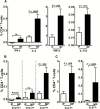Reduced T-Helper 17 Responses to Streptococcus pneumoniae in Infection-Prone Children Can Be Rescued by Addition of Innate Cytokines
- PMID: 28201637
- PMCID: PMC5441110
- DOI: 10.1093/infdis/jix090
Reduced T-Helper 17 Responses to Streptococcus pneumoniae in Infection-Prone Children Can Be Rescued by Addition of Innate Cytokines
Abstract
Background: T-helper (Th) 17 cells are important in the control of Streptococcus pneumoniae. We sought to understand the mechanism of failure of Th17 immunity resulting in S. pneumoniae infections in children <2 years old.
Methods: Peripheral blood mononuclear cells (PBMCs) from infection-prone (IP) and non-IP (NIP) children 9-18 months old were examined for their responses to heat-killed S. Pneumoniae, using flow cytometry, reverse-transcription polymerase chain reaction, and enzyme-linked immunoassay. We measured cytokine production, proliferation, and differentiation of Th17 cells and the expression of transcription factors in response to S. pneumoniae.
Results: PBMCs of IP children stimulated with heat-killed S. pneumoniae had significantly reduced percentages of CD4+ Th1 (interleukin2, tumor necrosis factor α) and Th17 (interleukin 17A) cells compared with NIP children. Addition of exogenous Th17-promoting cytokines (interleukin 6, 1β, and 23 and transforming growth factor β) restored CD4+ Th17 cell function in cells from IP children to levels measured in NIP children.
Conclusions: Reduced Th17 responses to S. pneumoniae in PBMCs of IP children can be rescued by addition of Th17-promoting cytokines.
Keywords: Pneumococcus; Th17; innate cytokines; young children..
© The Author 2017. Published by Oxford University Press for the Infectious Diseases Society of America. All rights reserved. For permissions, e-mail journals.permissions@oup.com.
Figures






Similar articles
-
Streptococcus pneumoniae fructose-1,6-bisphosphate aldolase, a protein vaccine candidate, elicits Th1/Th2/Th17-type cytokine responses in mice.Int J Mol Med. 2016 Apr;37(4):1127-38. doi: 10.3892/ijmm.2016.2512. Epub 2016 Mar 1. Int J Mol Med. 2016. PMID: 26935978
-
Characterization of Th17 responses to Streptococcus pneumoniae in humans: comparisons between adults and children in a developed and a developing country.Vaccine. 2012 Jun 6;30(26):3897-907. doi: 10.1016/j.vaccine.2012.03.082. Epub 2012 Apr 12. Vaccine. 2012. PMID: 22504663 Free PMC article.
-
Cigarette smoke alters the ability of human dendritic cells to promote anti-Streptococcus pneumoniae Th17 response.Respir Res. 2016 Jul 26;17(1):94. doi: 10.1186/s12931-016-0408-6. Respir Res. 2016. PMID: 27460220 Free PMC article.
-
Immunomodulatory effects of vitamin D on innate and adaptive immune responses to Streptococcus pneumoniae.J Infect Dis. 2013 Nov 1;208(9):1474-81. doi: 10.1093/infdis/jit355. Epub 2013 Aug 6. J Infect Dis. 2013. PMID: 23922371
-
Enhanced Th1 and Th17 responses in peripheral blood in active non-segmental vitiligo.Arch Dermatol Res. 2016 Dec;308(10):703-710. doi: 10.1007/s00403-016-1690-3. Epub 2016 Sep 29. Arch Dermatol Res. 2016. PMID: 27687555
Cited by
-
Immunologic dysfunction contributes to the otitis prone condition.J Infect. 2020 Jun;80(6):614-622. doi: 10.1016/j.jinf.2020.03.017. Epub 2020 Mar 20. J Infect. 2020. PMID: 32205139 Free PMC article. Review.
-
Pneumonia, Sinusitis, Influenza and Other Respiratory Illnesses in Acute Otitis Media-Prone Children.Pediatr Infect Dis J. 2021 Nov 1;40(11):975-980. doi: 10.1097/INF.0000000000003228. Pediatr Infect Dis J. 2021. PMID: 34382614 Free PMC article.
-
Comparison of pneumococcal conjugate vaccine (PCV-13) cellular immune responses after primary and booster doses of vaccine.Hum Vaccin Immunother. 2020 Dec 1;16(12):3201-3207. doi: 10.1080/21645515.2020.1753438. Epub 2020 May 13. Hum Vaccin Immunother. 2020. PMID: 32401658 Free PMC article.
-
Alveolar T-helper 17 responses to streptococcus pneumoniae are preserved in ART-untreated and treated HIV-infected Malawian adults.J Infect. 2018 Feb;76(2):168-176. doi: 10.1016/j.jinf.2017.10.013. Epub 2017 Nov 29. J Infect. 2018. PMID: 29197600 Free PMC article.
-
Streptococcus pneumoniae serotype 22F infection in respiratory syncytial virus infected neonatal lambs enhances morbidity.PLoS One. 2021 Mar 11;16(3):e0235026. doi: 10.1371/journal.pone.0235026. eCollection 2021. PLoS One. 2021. PMID: 33705390 Free PMC article.
References
-
- O’Brien KL, Wolfson LJ, Watt JP, et al. ; Hib and Pneumococcal Global Burden of Disease Study Team Burden of disease caused by Streptococcus pneumoniae in children younger than 5 years: global estimates. Lancet 2009; 374:893–902. - PubMed
-
- Pichichero ME. Otitis media. Pediatr Clin North Am 2013; 60:391–407. - PubMed
Publication types
MeSH terms
Substances
LinkOut - more resources
Full Text Sources
Other Literature Sources
Medical
Research Materials

